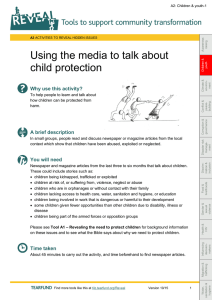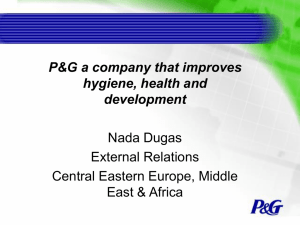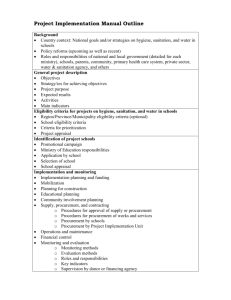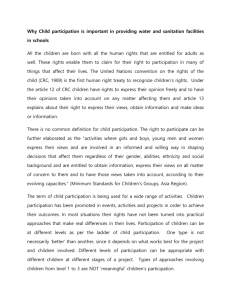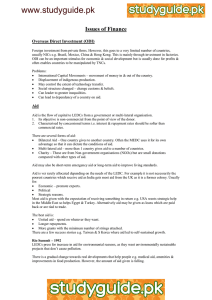A Making the case for sanitation and By Peter Newborne
advertisement
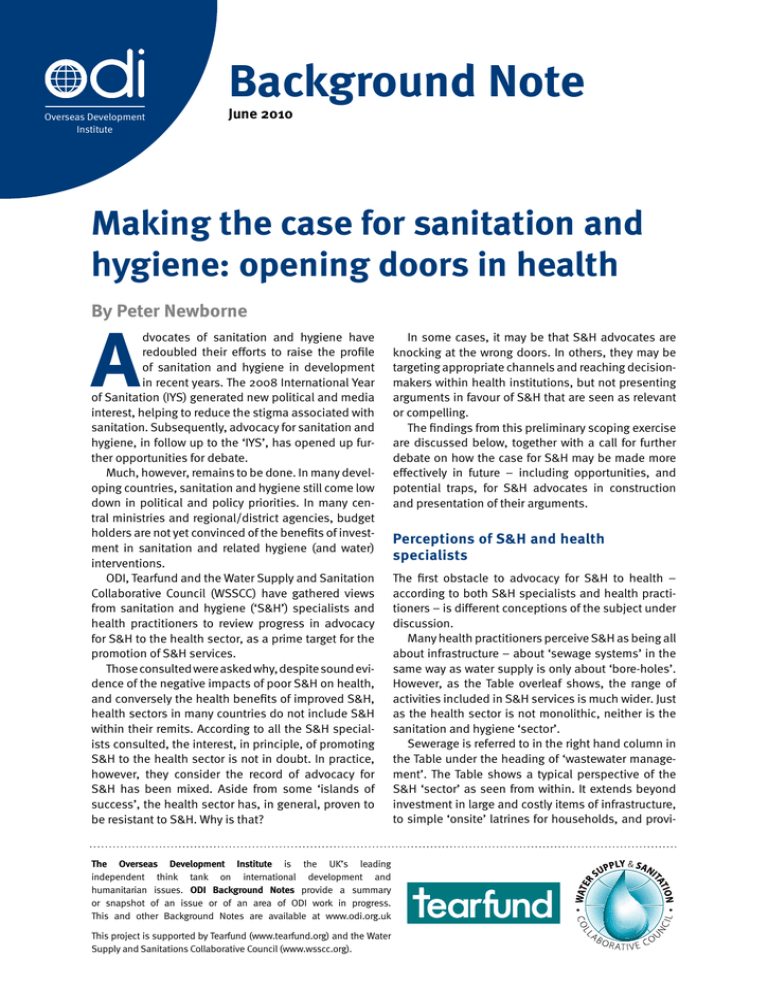
Background Note Overseas Development Institute June 2010 Making the case for sanitation and hygiene: opening doors in health By Peter Newborne A dvocates of sanitation and hygiene have redoubled their efforts to raise the profile of sanitation and hygiene in development in recent years. The 2008 International Year of Sanitation (IYS) generated new political and media interest, helping to reduce the stigma associated with sanitation. Subsequently, advocacy for sanitation and hygiene, in follow up to the ‘IYS’, has opened up further opportunities for debate. Much, however, remains to be done. In many developing countries, sanitation and hygiene still come low down in political and policy priorities. In many central ministries and regional/district agencies, budget holders are not yet convinced of the benefits of investment in sanitation and related hygiene (and water) interventions. ODI, Tearfund and the Water Supply and Sanitation Collaborative Council (WSSCC) have gathered views from sanitation and hygiene (‘S&H’) specialists and health practitioners to review progress in advocacy for S&H to the health sector, as a prime target for the promotion of S&H services. Those consulted were asked why, despite sound evidence of the negative impacts of poor S&H on health, and conversely the health benefits of improved S&H, health sectors in many countries do not include S&H within their remits. According to all the S&H specialists consulted, the interest, in principle, of promoting S&H to the health sector is not in doubt. In practice, however, they consider the record of advocacy for S&H has been mixed. Aside from some ‘islands of success’, the health sector has, in general, proven to be resistant to S&H. Why is that? The Overseas Development Institute is the UK’s leading independent think tank on international development and humanitarian issues. ODI Background Notes provide a summary or snapshot of an issue or of an area of ODI work in progress. This and other Background Notes are available at www.odi.org.uk This project is supported by Tearfund (www.tearfund.org) and the Water Supply and Sanitations Collaborative Council (www.wsscc.org). In some cases, it may be that S&H advocates are knocking at the wrong doors. In others, they may be targeting appropriate channels and reaching decisionmakers within health institutions, but not presenting arguments in favour of S&H that are seen as relevant or compelling. The findings from this preliminary scoping exercise are discussed below, together with a call for further debate on how the case for S&H may be made more effectively in future – including opportunities, and potential traps, for S&H advocates in construction and presentation of their arguments. Perceptions of S&H and health specialists The first obstacle to advocacy for S&H to health – according to both S&H specialists and health practitioners – is different conceptions of the subject under discussion. Many health practitioners perceive S&H as being all about infrastructure – about ‘sewage systems’ in the same way as water supply is only about ‘bore-holes’. However, as the Table overleaf shows, the range of activities included in S&H services is much wider. Just as the health sector is not monolithic, neither is the sanitation and hygiene ‘sector’. Sewerage is referred to in the right hand column in the Table under the heading of ‘wastewater management’. The Table shows a typical perspective of the S&H ‘sector’ as seen from within. It extends beyond investment in large and costly items of infrastructure, to simple ‘onsite’ latrines for households, and provi- Background Note Table: Broad elements of sanitation, hygiene, and wastewater management Sanitation • Safe collection, storage, treatment and disposal of human excreta (faeces and urine) • Management/re-use/recycling of solid waste (e.g. households) (rubbish) • Collection and management of industrial waste products • Management of hazardous wastes (including hospital wastes, chemical/ radio-active and other dangerous substances). Hygiene • Safe hand washing practices • Safe water storage (by households) • Safe treatment of food stuffs. Wastewater management • Drainage and disposal/reuse/recycling of household wastewater (also referred to as ‘grey water’) • Drainage of storm water • Treatment and disposal/ reuse/recycling of sewage effluents. Source: Adapted from B. Evans (2005) sion of ‘soft’ items, including promotion of changes in hygiene practices. This broad range of elements means that there is ample opportunity for confusion, especially given that different contexts entail different means of S&H delivery. The places where people live without access to sanitation facilities, or knowledge and understanding of personal hygiene, range from densely populated urban slums to remote rural villages. S&H advocates need to choose appropriate words – and preferably images – to transport their interlocutors into those worlds of urban and rural S&H, and articulate how the provision of S&H services in each setting is relevant to the health sector. Those slums and villages, where S&H programmes concentrate much of their efforts, are far from the focus of attention of the health sector in developing countries, which, by common agreement of the respondents to this study, is on hospitals and clinical centres. Health services are ‘medicalised’ – peopled predominantly by doctors and members of the medical profession, whose training emphasises higher technical skills, not ‘basic things like hygiene’. S&H comes low down in the ‘intellectual pecking order’ of the health sector, and this is reflected in the attitudes of health planners, at senior and middle decisionmaking levels. Although some former doctors in health ministries and bureaus are open to S&H, the respondents to this study considered that those are exceptions in health circles where there is commonly a ‘cultural block’ that tends to see hygiene as irrelevant to the health profession and even beneath it. Commonly held views in the minds of many health specialists are that:• S&H is advocated by a ‘club’ of specialists, pushing a narrow sectoral perspective; • the setting of disease control priorities, equipping of new hospitals and provision of drugs are more important and exciting than S&H; • S&H does not offer the kind of short-term gains that health programmers want to support; • behaviour change is important, as recognised, for 2 example, by HIV and AIDS experts, but achieving lasting behaviour change is a slow process – which is also complex: ‘everyone has their own idea of how to go about it’; • S&H is ‘old news’: the importance of improvements in S&H was long ago recognised ‘by health people’, in the mid-1800s, but it no longer interests populations of developed countries and their donor agencies; • to allocate health budgets to S&H would be to deviate funding from more ‘deserving’ areas, especially in the resource-scarce contexts prevailing in lowincome countries. Resourcing The perception of the health specialists consulted is that delivery of improvements in S&H ‘requires major funding’, way beyond the resources available to health care agencies. Already, they say, huge demands are placed on health services. The principal preoccupation of most health managers is maintaining the flow of funds for hospitals and health care facilities and the salaries of their staff. Lip service, noted several respondents, may be paid to the need for S&H, but often there are ‘no budgets’ for preventive activities such as S&H. Environmental health/public health and maternal/child health tend to involve ‘ongoing, endless tasks’ that demand recurrent budgets. In resource-scarce health systems in low-income countries, budgets for field allowances (for fuel and vehicles) are cut before salaries, so district health workers tend to be immobilised in their premises without the resources to visit the field. Where S&H interventions are included in health programmes, one S&H expert observed a tendency for the S&H activities to be ‘add-ons’, disconnected from programme components designed to address national disease reduction priorities, i.e. ‘a little bit of S&H’ in X or Y district, without proper planning for integration of the S&H interventions into health components, or working at scale. Junior staff with training in environmental health are commonly sent to (remote) rural health centres where they have to make up for the lack of doctors by giving out drugs and medicines, rather than exercising the skills for which they were trained. In national administrations, ‘S&H has fallen between the gaps’. S&H is often not picked up by ministries of health, and experience has shown (Tearfund/ ODI, 2007) that only some of the elements in the Table fit, naturally, under ministries of water. Meanwhile, in many local governments, where there were once departments dedicated to ‘health’ and ‘engineering’, such functions have been transferred to other public bodies, or outsourced to private contractors. The focus of health services in many countries is on curative health – on ‘giving out drugs’. The preventive aspect has often fallen by the wayside, despite being at the heart of primary health care. The Declaration of Alma-Ata of 1978, which sought to place primary health care as an integral part of national health systems, has been de-prioritised by most health professionals in developing countries – and with it, the preventive role of S&H. This runs counter to the view of S&H specialists for whom hygiene promotion (e.g. hand-washing) aligns naturally with health. Box 1: Health ‘systems’ as defined by WHO ’A health system consists of all organizations, people and actions whose primary intent is to promote, restore or maintain health. This includes efforts to influence determinants of health as well as more direct healthimproving activities. A health system is therefore more than the pyramid of publicly owned facilities that deliver personal health services … It includes inter-sectoral action by health staff…’. Source: WHO (2007), ‘Everybody’s business: strengthening health systems to improve health outcomes’, Framework for action. Box 2: Six health sector functions to prevent a significant portion of the disease burden 1) Ensuring that environmental health issues are adequately reflected in inter-sectoral policy development and implementation; 2) Setting and overseeing the implementation of healthprotecting norms and regulations; 3) Incorporating environmental health in disease-specific and integrated health programmes; 4) Practising environmental health in health-care facilities; 5) Preparing for and responding to outbreaks of environment-mediated diseases; 6) Identifying and responding to emerging threats and opportunities for health. How can S&H ‘fit’ within the roles of health practitioners? Despite wide acceptance in health circles that improved S&H contributes to better health, health practitioners question whether S&H falls under the responsibilities of the health sector. Health practitioners understand fecal-oral transmission of disease, but in general consider that S&H is not their concern: ‘the health sector is not concerned with the wider social determinants of health’. This is despite the definition of health ‘systems’ proposed by the World Health Organisation (WHO), reproduced in Box 1, which includes indirect determinants of health. This definition, according to the respondents, is not generally accepted by health practitioners in developing countries. In their view, S&H is part of broader development issues and leadership of S&H as a ‘multi-sectoral’ issue should come from elsewhere. If, then, S&H advocates are to argue that health systems have to integrate S&H, they need to be clear which elements they are proposing that health services pick up. A group of experts has proposed a number of health sector functions that are ‘critical in securing environmental health gains’ (Box 2). S&H specialists, they note, need to present compelling arguments that these functions are part of the ‘day-jobs’ of health officials and practitioners. Source: Rehfuess, E., Bruce, N. and Bartram. J. (Dec. 2009). Box 3: Infection control in hospitals and health systems TB bacteria usually attack the lungs and spread through the air from one person to another. Crowded premises are fertile places for quick transmission, especially in poor areas. Alongside prisons, where inmates live in close proximity and often in poor conditions, hospitals are public places where the lack of ventilation and poor hygiene can create a breeding ground for TB. The number of countries reporting cases of extensively drug resistant tuberculosis, called ‘XDRTB’, has increased substantially over the past three years, reaching 55 in 2009. This is causing considerable concern in health circles. WHO estimates that about 5% of newly diagnosed cases of TB every year are multi-drug resistant. Of those cases, some 60,000 infections are of the fatal, almost impossible to treat, variety. Source: IRIN, Humanitarian News and Analysis, www. irinnews.org 3 Background Note One respondent considered that current debates within health circles on strengthening of health systems offer an opportunity to make the case that certain elements of S&H are integral to the good functioning of health systems. A tuberculosis (TB) expert mentioned the increased attention paid by the health sector to a systems approach that could, for example, apply to infection control in hospitals and health care facilities (Box 3). To-date, the expert said, pleas for more resources for infection control in developing countries have fallen on deaf ears. It has been difficult to find, within ministries of health, ‘champions’ of improved standards of hygiene in health care facilities. But, if health facility managers, faced with a rise in infections, were told how the costs of unnecessary infections could be reduced by attention to hygiene, ‘they would surely sit up and listen’. Poor housing and environmental conditions aid the transmission of TB and the great majority – 80% of XDR-TB cases – are linked to poor S&H. So, commented this expert, TB prevention could become a natural ally of S&H. While S&H has not been a regular topic of conversation among health professionals working on TB, they are becoming increasingly aware of it. Meanwhile, several of the health practitioners consulted commented that S&H specialists need to deepen their understanding of health systems and health services, to think themselves more into ‘health shoes’. S&H advocacy – the record to date Several respondents expressed the view that health professionals tend to be ‘inundated’ with evidence on the relevance of S&H to health. ‘Enough evidence already exists’, for example, on the consequences of poor S&H on infants and children, and on the cost/ benefit effectiveness of investing in S&H to achieve positive health benefits. Instead, S&H advocates could usefully produce more data on the detrimental effects of poor S&H on adults, in terms of their cognitive ability and productivity, targeting other ministries with this information, e.g. labour, economic development. According to this viewpoint, the solution lies in improving the communication of existing evidence. Sound scientific findings need, respondents said, to be allied with strong messages. Although a sound scientific and technical base constitutes a necessary condition of constructing a line of argument for S&H, it is not enough for a successful case. Each argument presented for S&H has to pass other filters in the minds of its audience, including non-scientific reactions and perceptions. ‘The technicians have argued poorly. The human dimension, including equity, is much more powerful. We do need technical argu- ments, but often we need to sway with appeal to emotions’. For example, HIV and AIDS specialists have succeeded in promoting their subject as a headline issue, clearly communicating it as a health problem which has resonance. How, asked one S&H specialist, can S&H present itself in a similarly concise and powerful manner? Another respondent expressed a more fundamental doubt: whether scientists will succeed in pinning the blame for illnesses and diseases on failings in S&H. Diarrhoea, for example, kills a large number of children/infants, but poor S&H is one of the multiple causes of diarrhoea. And the quality/accuracy of data on diarrhoea itself is poor – ‘subjective and skewed’. Attempting to make a case for S&H on the basis of such evidence could be a blind alley, this S&H specialist argued, if it is not possible to eliminate gaps in the epidemiological case. Even gathering evidence of trackable, easy-to-detect illnesses, caused by poor hygiene, such as the skin disease scabies which can be diagnosed directly – is a major challenge in developing countries. In terms of which doors in health circles to knock on, one S&H specialist felt it was no good talking to middle-managers in health administrations. S&H advocacy needed to identify the decision-makers, at a higher level, and those sympathetic to S&H. This view emphasises the need for S&H advocates to be selective about the constituencies to which their advocacy is targeted. For S&H specialists, behaviour change is undoubtedly a fundamental part of achieving and implementing S&H. In principle, said one respondent, there is ‘no excuse for health people’ not to take on S&H, alongside e.g. child and maternal health care. The role of government in relation to promotion of behaviour change, another respondent commented, ‘provides an opportunity to rejuvenate health ministries around behaviour change’. ‘The Minister of Health should be the principal ally of S&H’. But, given the expressed reticence of health policy-makers and planners, as noted above, is behaviour change really the right ‘ticket’ for advocacy on S&H? Strengthening the case for S&H S&H advocates need to think of ways of presenting S&H in a constructive light, taking account of the contexts, alluded to above, of scarce resources in many health services in low-income countries. S&H specialists can aim to express the links between S&H and broader development issues, thereby leaving behind the clubby, cliquey image of S&H (noted above). S&H advocates may, for example, 4 Background Note argue for S&H as key to the promotion of environmental health in low-income areas. In June 2008, 17 international agencies forming the Poverty-Environment Partnership published a paper arguing for the placing of environmental health on national development agendas. Ministers of health and environment from over 50 countries in Africa came together, in August 2008, with the support of UNEP and WHO, to adopt the Libreville Declaration on Health and Environment. In the context of rapid urbanisation in many countries in Africa, does not S&H as a key to environmental health in urban contexts offer a promising line of argument? An example of a recent success by Tearfund partner, PPSSP(Programme de Promotion des Soins de Santé Primaires en Zones de Santé Rurales), was persuading the provincial government in Goma and the town hall (mairie) in Beni, in the east of the Democratic Republic of Congo (DRC), to improve the drainage in both urban centres (with support from UNDP). This national NGO has had good experience of working with the provincial government and linking to community action, including awareness-raising campaigns (sensibilisation) on cleaning up of urban areas: nettoyage des lieux publics. The improvements in both urban Goma and Beni centres are now very evident. Cleaner public places motivate people to pay more attention to S&H. The lesson this S&H advocate draws is the need to be flexible as to which elements of S&H are chosen as the base of advocacy arguments in a given context. The S&H elements (in the Table above) put to the fore in Goma/Beni were wastewater and solid waste disposal. S&H advocacy needs to employ different ways to approach different interlocutors with different types of evidence: ‘S&H plays in many fields – so it has to field many arguments’. Depending on local conditions, the significance of S&H in reducing the disease burden might mean making the case for S&H differently. Aggregate figures across Africa and globally point to diarrhoea as the second greatest killer of children – more than AIDS, malaria and measles combined (according to recent evidence from UNICEF/ WHO). However, the biggest killer of children, infants and adults in the east of DRC is malaria. S&H is linked to both the problem and the solution of malaria. In the local climate, improving wastewater and drainage systems to disperse the stagnant waters in which malarial mosquitoes breed is an important part of reducing the disease. Another example is related to countries where intestinal worms are a major health problem. There is good evidence, noted one S&H expert, that intestinal worms affect cognitive development, and reduce the mental power of adults. ‘Do heads of state and prime 5 ministers want their citizens to suffer such debilitating states’ – for the country to lose the benefit of their full working capacity – i.e. in terms of lost productivity, akin to HIV and AIDS? One health specialist commented that NGOs need to continue to keep alive the debate on the paucity of health services available to poor populations and areas, and issues of unequal access, including by reference to the ‘right to health’. This, they said, is an important advocacy role for civil society, as well as supporting implementation projects to fill gaps in government provision. In resource-scarce contexts, where neither government or NGO or donor funding is available, ingenuity is required to create opportunities and incentives for staff. One respondent cited an example of good collaboration at district level between officers with different sectoral and thematic responsibilities which allowed rural extension workers to ‘piggy-back’ on each other’s field resources. In contrast, another cited the collaboration agreement between three ministries at national level – an interesting institutional innovation that had not, however, been translated into coordination at district level. S&H advocates can argue, said several respondents, that health ministers who invest some funds in S&H, can lever much more. A small amount of money invested in S&H can go a long way. Households will cover some costs themselves, and S&H advocates can ‘sweeten the pill which the health sector has to swallow’. As discussed above, given that health ministries start from the assumption that S&H is not part of their job, advocates for S&H need to point to the functions that can properly be picked up by health professionals as part of their daily roles. Currently, there are ‘no clear messages’ to health on ‘what to do and how to it’. Thought is also required on the cost implications: what will this cost, in human and financial resources? ‘The work required to prepare these arguments is only beginning’. Building capacity – the long-term solution The broad agreement among S&H practitioners is that more training of health staff in preventive interventions is needed, with budgets to match. Currently, few training schools and low budgets mean that countries lack the ability to attract new recruits into public health. Qualifications in environmental health are commonly at diploma level, placing them at a lower level than the degrees and advanced degrees in medicine. Encouragingly, a degree level course in environmental health has recently been created in the University of Zambia. In some developed countries, health inspectors have created environmental health associations, according them a professional identity and status. The inspectors’ role includes the important function of monitoring public health– a proven model of how governments may manage to maintain an operational cadre of public health inspectors. In rural Ethiopia, this capacity is in the process of being built, and one S&H expert noted the progress being made in this direction in Uganda. As this specialist commented: ‘Community health workers are back in favour in Africa, after being criticised in the 1980s for being ineffective, essentially due to lack of resourcing. ‘Effort needs to be put once more into building capacity: people – many people – adequately trained and remunerated, are required’. When the upper echelons of health ministries include environmental health graduates, there will be a pool from which may emerge future champions of S&H at influential decision-making levels. Box 4: Research Agenda Aspects of advocacy for sanitation and hygiene that merit further research are:• advocacy strategies and techniques: evaluation of patterns to-date of S&H advocacy in selected countries: different approaches; targets; evidence base; messages; successes/failures; innovations; • political economy of target sectors and themes: starting from the perspective of S&H stakeholders, investigate the dynamics of policy-making, budgetary decisions, resource allocations and spending in the health and other sectors in selected countries; • fragile states: S&H advocacy in fragile states and other difficult contexts; • aid effectiveness: analysis of how development cooperation/assistance funds are channelled to S&H via health and other key sectors(e.g. the role of sector wide approaches-SWAps). Research agenda Further research could usefully pursue a number of areas and issues arising out of this preliminary scoping study, as set out in Box 4. The research would be part of a dialogue that would bring together groups of actors from the health, S&H and other sectors to highlight successful approaches to S&H advocacy and support the strengthening of future advocacy efforts. Written by Peter Newborne, Research Associate (p.newborne.ra@ odi.org.uk). The contributions of Fiona Samuels, ODI, Sue Yardley and Mari Williams of Tearfund, and Saskia Castelein of WSSCC are gratefully acknowledged. References and background information Dye, C. et al. (2009) ‘Trends in tuberculosis incidence and their determinants in 134 countries’, Bulletin of the World Health Organisation 87: 683-691. Evans, B. (2005) ‘Securing Sanitation: The Compelling Case to Address the Crisis’. Stockholm and Geneva: Stockholm International Water Institute in collaboration with WHO. Newborne, P. and Samuels, F. (2009) ‘Report of preliminary scoping study – Making the case for sanitation: opening doors within health’. London: ODI, Tearfund and Water Supply and Sanitation Collaborative Council (WSSCC). Newborne, P. and Welle, K. (2006) ‘Sanitation and hygiene: Knocking on new doors’. ODI Briefing Paper no. 13. London: ODI (www.odi.org.uk/publications/briefing-papers/13sanitation-hygiene.pdf). Poverty-Environment Partnership (2008) ‘Poverty, Health and Environment – Placing Environmental Health on Countries’ Development Agendas’. Joint Agency Paper of the PovertyEnvironment Partnership, a collaboration between seventeen agencies, June. Rehfuess, E., Bruce, N. and Bartram, J. (2009) ‘More health for your buck: health sector functions to secure environmental health’, WHO bulletin for December. Geneva: WHO. Tearfund/ODI (2007) ‘The Sanitation Scandal’. London: Tearfund and ODI. WHO (2008) ‘Report of the second meeting of the WHO task force on XDR-TB’, 9-10 April, Geneva. WHO (2007) ‘Everybody’s business: strengthening health systems to improve health outcomes’, WHO’s framework for action. Geneva: WHO. Interviews with health experts were carried out by ODI health specialist Fiona Samuels, and with S&H specialists by ODI water and sanitation specialist Peter Newborne. Both groups comprised those who have worked in-country and at global/international level. The S&H specialists included representatives of national/ local NGOs, including ‘WASH’ coordinators in Asian and African countries whose experience offers insights into the day-today challenges of S&H advocacy. Their perceptions of how S&H is promoted are summarised in this Background Note and, based on these insights, this report considers preliminary implications from an advocacy perspective. The contributions of those who agreed to be interviewed are gratefully acknowledged. Overseas Development Institute, 111 Westminster Bridge Road, London SE1 7JD, Tel: +44 (0)20 7922 0300, Email: publications@odi.org.uk. This and other ODI Background Notes are available from www.odi.org.uk. Readers are encouraged to quote or reproduce material from ODI Background Notes for their own publications, as long as they are not being sold commercially. As copyright holder, ODI requests due acknowledgement and a copy of the publication. The views presented in this paper are those of the authors and do not necessarily represent the views of ODI, Tearfund or WSSCC. © Overseas Development Institute 2010. ISSN 1756-7610.
